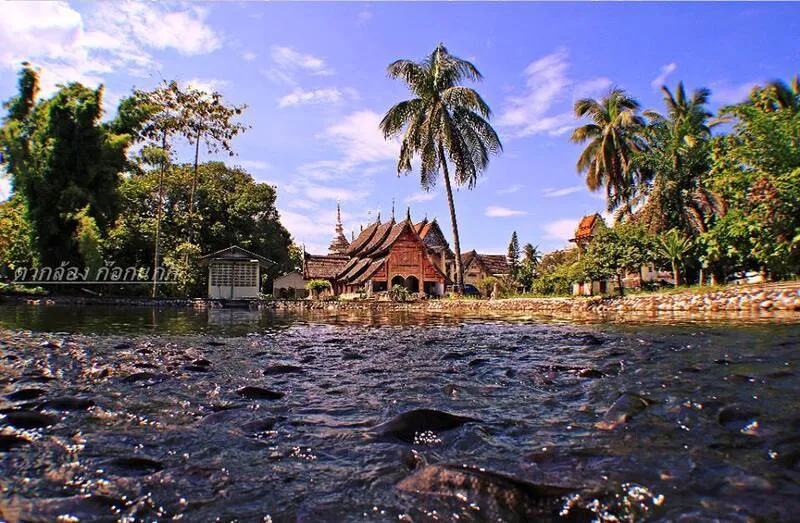Wat Hua Khuang

Rating: 2.9/5 (23 votes)
Lampang attractions
Attractions in Thailand
Operating day: Daily
Operating time: 08.00 - 17.00
Wat Hua Khueang, located at No. 151, Pratu Ma, Wiang Nuea Subdistrict, Mueang Lampang District, Lampang Province, Postal Code 52100, covers an area of 7 rai and 11 square wah. It is a Theravada Mahanikaya Buddhist temple that was officially established in 1767 (B.E. 2310) and was granted the Royal Ordination Boundary in 1812 (B.E. 2355). The abbot is Phra Khru Suthamajanwat Ajan Dhammo.
The vihara (ordination hall) of Wat Hua Khueang is constructed in the traditional Lanna architectural style and was built during the early Rattanakosin period, when people from Chiang Saen were forcibly relocated to Lampang. This wooden structure not only reflects Lanna craftsmanship but also holds historical significance, as it was built by the Chiang Saen people who were resettled here (Chiang Saen is currently a district in Chiang Rai Province).
Since the early Rattanakosin period, the artistic features of the vihara have served as evidence of this historical episode. The vihara also offers insights into the distinctive styles of Lanna art across various regions. As Chiang Saen District now retains very little of its traditional local artistry, this vihara can be studied as a substitute reference for such styles.
Wat Hua Khueang’s vihara was officially registered as a historic monument and its boundary designated in the Royal Gazette, Volume 97, Part 159, dated October 14, 1980.
The Buddha image in the Maravijaya posture at Wat Hua Khueang has general features similar to Phra Chao Thong Thip. The facial features reflect a blend of two artistic influences. The robe’s hem, which reaches down to the waist, appears shorter than usual—possibly because the waist area was elongated to complement the slender figure. This is similar to the Buddha image in the Maravijaya posture at Wat Phra That Chang Kham Worawihan. Both statues are dated to around the first half of the 21st Buddhist century.
The Buddha image in the meditation posture at Wat Hua Khueang has an oval-shaped face, arched eyebrows, small downward-looking eyes, a prominent nose, long and narrow lips, large curls of hair, and a pointed flame-like ushnisha (cranial flame). The robe is draped over one shoulder with only one breast visible. The hem of the robe is cut straight. The base is rounded with three legs.
The chedi (stupa) at Wat Hua Khueang is located within the temple grounds in Nai Wiang Subdistrict, Mueang Nan District, Nan Province. It is a prang-style chedi, influenced by Lanna art. The lower base is a square platform supporting two layers of lotus moldings, separated by a mid-level square platform.
The upper lotus base has indented corners supporting the relic chamber, which rises to meet a set of three superimposed lotus moldings beneath the bell-shaped dome. Each side of the relic chamber features an arched niche housing a bronze Buddha image in the Maravijaya posture. On both sidewalls, there are stuccoed divine figures in royal attire standing with palms pressed together. The uppermost section features three stacked lotus moldings.
The bell-shaped dome is small and lacks a throne. Its overall shape is similar to the chedi at Wat Lok Moli in Mueang District, Chiang Mai Province, built during the reign of Phra Mueang Ket Klao around 1528 CE (B.E. 2071). However, the lower base and the stacked lotus moldings of this chedi have been raised higher, giving it a more slender and taller appearance. This represents an evolution of the form, adapted by Nan craftsmen in a later period, and the chedi likely dates no earlier than the first half of the 22nd Buddhist century.
Comment
| Keyword (Advance) |
 Facebook Fanpage
Facebook Fanpage

 Category:
Category:  Group:
Group:  Art, Culture and Heritage
Art, Culture and Heritage Historical Sites and Monuments(
Historical Sites and Monuments( Landmarks and Memorials(
Landmarks and Memorials( Art, Craft Centres, Tradition(
Art, Craft Centres, Tradition( Museums(
Museums( Historical Houses and The Ancient City(
Historical Houses and The Ancient City( University
University Other religious and spiritural sites(
Other religious and spiritural sites( Research and Development
Research and Development Royal Project(
Royal Project( Suburban Living
Suburban Living Village, Community(
Village, Community( Local Market(
Local Market( Nature and Wildlife
Nature and Wildlife National Parks and Marine Reserves(
National Parks and Marine Reserves( Mountain (Doi)(
Mountain (Doi)( Dam, Reservoir, Lake(
Dam, Reservoir, Lake( Waterfalls(
Waterfalls( Hot Springs(
Hot Springs( Caves(
Caves( Flower Field(
Flower Field( River, Canal(
River, Canal( Bays and Beaches(
Bays and Beaches( Other natural attractions(
Other natural attractions( Entertainment and Agricultural
Entertainment and Agricultural Animal camps and shows(
Animal camps and shows( Farm, Parks, Gardens and Ecotourism(
Farm, Parks, Gardens and Ecotourism( Outdoor and Adventure Activities(
Outdoor and Adventure Activities( Shopping
Shopping Shopping and Night Market(
Shopping and Night Market( Spas and Wellness
Spas and Wellness Spas and Wellness(
Spas and Wellness(